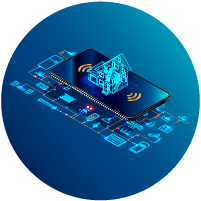IoT Penetration Testing!
Penetration testing services for IoT systems identify particularly critical security vulnerabilities.
These vulnerabilities have the potential to compromise various systems, including ATMs, smart
vehicles, medical equipment, and industrial technology systems, making them susceptible to
threats.
0K
0K
0K
0Μ
With IoT Growth, Comes Increased Security Concern
With the increasing incorporation of IoT devices in everything from smart vehicles and home systems to industrial applications and beyond, it is expected that the number of these devices will surge to 25 billion by 2030.
Considering this rapid growth and projected future expansion, penetration testing for IoT systems has become essential for businesses aiming to evaluate, comprehend, and fortify their security measures.
IoT systems have become frequent targets of cyber-attacks, often being exploited to access sensitive information or to take control of information systems. Our services are expertly crafted to assist you in identifying and addressing any security vulnerabilities present in your devices.
IoT Security Testing
Penetration testing in IoT systems is a process focused on evaluating the security of smart devices to identify potential threats and vulnerabilities, both in hardware and software. Its ultimate goal is to protect against unauthorized access, data manipulation, information theft, or other types of cyber-attacks.
In the modern era, consumers use increasingly advanced technology in their daily lives, including ATMs, vehicles, medical devices, industrial applications, electronic locks, smart mirrors, refrigerators, speakers, smartwatches, thermostats, printers, security cameras, and many more. IoT devices facilitate business operations and people’s everyday lives, but how secure is this technology?
Unfortunately, in many cases, IoT system security is often overlooked or businesses are not fully aware of the risks associated with these devices. IoT systems are equally vulnerable to attacks like any other informational system, and as such, they must undergo continuous testing and comply with security standards.




What to expect from Logisek's IoT penetration testing services
Logisek goes well beyond the OWASP Top 10 methodology when it comes to detecting and exploiting vulnerabilities during IoT penetration testing.
We seek vulnerabilities that are either not widely known yet or discover new ones. Throughout our testing process, we thoroughly investigate the entire ecosystem of IoT devices, from the physical aspects of the device and hardware characteristics to how it communicates and interacts with end-users.
Here are a few specific areas that we meticulously scrutinize during our examination:
- Internal communication protocols like UART, I2C, SPI, and more
- Open ports
- JTAG debugging
- Retrieve and examine firmware from EEPROM or FLASH memory
- Tamper testing
- Binary analysis
- Reverse engineering
- Analyzing file system
- Examine key and certificates
- Firmware modification
- The exploitation of communication protocols such as BLE, Zigbee, LoRA, 6LoWPAN
- Sniffing radio packets
- Jamming attacks
- Modifying and replaying packets
- Web dashboards (XSS, IDOR, Injections, etc.)
- Source code review for .apk and .ipa files
- Application reversing
- Hardcoded API keys
- Cloud credentials like MQTT, CoAP, AWS, and more

Secure your Devices

Enhancing Security Measures

Reducing Operations Costs

Protect your Data
Our Approach
At Logisek, we have a seasoned team of certified security consultants specializing in IoT penetration testing. Our engineers collaborate closely with your business team to establish the precise scope of security assessments for your smart devices.
Indeed, the requirements for penetration testing can significantly differ from one product to another.
The expertise of our consultants in penetration testing ensures that nothing is overlooked, and the latest security standards are followed to protect your business's data and resources.
During the information gathering phase, Logisek employs advanced Open-Source Intelligence (OSINT) techniques to passively collate publicly available information. This data, potentially exploitable by malicious actors, could compromise your organization's security.
Publicly available data not only serves as a substantial source of information, but it also can unveil potential risks to your business that might have gone unnoticed or of which you might not be aware. Such information can be harvested from various sources, including search engines, social networking sites, source code repositories, forums, and even the obscure corners of the dark web.
Leveraging OSINT techniques, we amass intelligence about your organization's online footprint, potential vulnerabilities, exposure of sensitive information, and any other relevant data that could influence your security posture. This proactive strategy enables us to pinpoint potential threats and vulnerabilities that could be exploited by attackers, thereby fortifying your overall security posture and reducing possible risks.
Logisek deploys a range of dynamic information-gathering tools and methodologies during the enumeration phase to identify all conceivable attack vectors. This involves an in-depth analysis of the system's configuration and characteristics, seeking out any potential weak points that could be exploited by attackers.
Information assembled from the fingerprinting and enumeration phase - which includes detailed profiles of each component in the IoT system - is combined with the insights gained during the information gathering and reconnaissance phase. These phases encompass thorough scrutiny of the broader network environment and potential external threats. All this compiled information serves as a robust foundation for our ensuing attack simulation and exploitation phase, allowing us to design and execute precise, realistic threat scenarios to thoroughly test your IoT system's resilience against cyber-attacks.
Once vulnerable points have been identified, Logisek utilizes the collected information from the preceding stages to execute a multifaceted approach that combines automated and manual penetration testing. The objective is to exploit the discovered weaknesses in your business's IoT devices.
A particular emphasis is placed on ensuring data protection throughout the process. We exercise the utmost caution to prevent any disruptions to the productive functioning of your IoT systems, maintaining the integrity of your operations even as we test for potential security vulnerabilities.
We produce a comprehensive and detailed written report that goes beyond simply cataloging the vulnerabilities we discovered during the assessments. It also encompasses a thorough analysis delineating the nature of the risks, their potential impact on your business, and specific pragmatic recommendations on how they can be effectively addressed and mitigated.
We place particular emphasis on formulating our recommendations in a manner that is comprehensible, actionable, and contributes to the construction of a stronger and more secure infrastructure for your organization. Our objective is to equip your team with the requisite knowledge and tools to proactively combat and strategically respond to any security threats.
The report provides insights and serves as a roadmap for enhancing your overall security posture. It empowers you to prioritize and allocate resources effectively, ensuring that security measures are implemented in a focused and efficient manner.
Furthermore, our team is available for consultation to discuss the findings and recommendations in detail, addressing any questions or concerns you may have.
By delivering this comprehensive report and arming your team with the necessary knowledge, we enable you to take preventive measures and strategically respond to any security threats that may surface.
t Logisek, we regard the implementation of remediation testing as a crucial aspect of our penetration testing process. These tests are performed after your team has taken corrective actions to address the identified vulnerabilities, with the objective of verifying the effectiveness and accuracy of the measures implemented.
We underscore the importance of iterative verification, as it significantly aids in ensuring that the adjustments made by your team are adequate and have achieved the intended results.
Moreover, the process of verification and remediation offers the necessary evidence of risk reduction or mitigation, strengthening your standing with certification bodies and clients by evidencing your commitment to maintaining high security standards.
Upon the conclusion of the remediation tests, we furnish you with an updated report reflecting the current security status and an assessment of the actions undertaken.

Final Deliverable
At Logisek, we prioritize thorough documentation of all information pertinent to the findings from the security assessments we conduct. Our reports encapsulate detailed descriptions of the technical findings, analyses of associated risks, guidance and recommendations, as well as step-by-step instructions for reproducing the identified vulnerabilities.
Each report is subjected to a rigorous Quality Assurance (QA) process prior to delivery to ensure the accuracy, completeness, and reliability of its content.
Our reports are specifically structured with the following sections:
Frequently asked questions about ΙοΤ penetration testing
ΤThe most common IoT vulnerabilities we find are the following:
Inadequate password security: Many IoT devices come with default passwords that users often neglect to change, making them an easy target for cybercriminals.
Lack of encryption: Without proper encryption, data being transferred from IoT devices can be easily intercepted and exploited by malicious entities.
Outdated software: Just like traditional computers, IoT devices run on software that needs to be regularly updated. Many devices don't receive the necessary updates and patches, leaving them vulnerable to known exploits.
Insufficient privacy protections: IoT devices often collect large amounts of data, and if they don't have robust privacy protections in place, this data can be easily accessed and misused.
Poor network security: IoT devices are often connected to home or business networks. If these networks aren't secure, they can serve as a gateway for hackers to access not only the IoT devices but all other connected devices as well.
Physical tampering: Unlike traditional computers, IoT devices are often in easily accessible locations and can be physically tampered with, causing security breaches.
Insecure APIs: Many IoT devices communicate with servers using APIs. If these APIs are not secured properly, they can be exploited to gain unauthorized access to the device or to the data it holds.
Insecure Web Interfaces: Some IoT devices have built-in web interfaces for easier management and configuration. However, if these are not secured adequately, they can become a point of entry for attackers.
Lack of Device Authentication: Without proper device authentication procedures, it's hard to ensure that only authorized devices can connect to your network and communicate with your other IoT devices.
Insecure Mobile Applications: Many IoT devices come with associated mobile apps for convenience. If these apps are not developed with security in mind, they could present vulnerabilities that can be exploited.
Insecure Cloud and Network Interfaces: IoT devices often communicate with cloud servers or other network devices. If the communication interfaces are insecure, they could be leveraged by attackers to gain access to the device or network.
Lack of Secure Update Mechanism: Devices without a secure, automated update mechanism can remain in an insecure state for longer periods, leaving them open to known exploits that have already been fixed in later versions of the software.
Device Firmware Vulnerabilities: The firmware used in IoT devices can also contain vulnerabilities that attackers can exploit to gain control of the devices or access sensitive information.
Poorly Designed Communication Protocols: IoT devices use various communication protocols. If these are poorly designed or implemented, they can create vulnerabilities and potential attack vectors.
These vulnerabilities, among others, underline the necessity for robust security measures, thorough testing, and regular updating of IoT devices to keep them secure.
The selection of tools for the security assessment is primarily guided by the specific characteristics of the IoT device undergoing testing. For instance, considerations include whether the device utilizes wireless, wired, or Bluetooth connections, or if it features any management interfaces.
We deploy a diverse array of tools specifically suited to the individual requirements of each assessment scenario.
The tools potentially employed might encompass the following:
- Expliot – IoT Exploitation Framework
- Routersploit – Exploitation Framework for Embedded Devices
- IoTSecFuzz – Comprehensive Testing Tool for IoT Devices
- HomePwn – Swiss Army Knife for Pentesting IoT Devices
- killerbee – Zigbee Exploitation
- HAL – Hardware Analyzer
- FwAnalyzer – Firmware Analyzer
- ISF – Industrial Security Exploitation Framework
- PENIOT – Penetration Testing Tool for IoT
- IDA Pro – Interactive Disassembler
- GDB – GNU Project Debugger for Debugging C/C++
- Ghidra – GNU Project Debugger Suite of Tools Designed by the NSA
- BurpSuite – An Integrated Platform/Graphical Tool for Performing Security Testing of Web Applications
In certain instances, our clients prefer to concentrate the assessments on specific facets of their IoT systems, which enables us to carry out remote testing.
However, for a majority of the assessments, it becomes imperative for us to physically possess the device to ensure a thorough and comprehensive evaluation.
The frequency of vulnerability scans hinges on several variables, including the nature of the information systems, the industry of the business, security prerequisites, and the changes that may occur in the operating environment.
As a broad guideline, IoT penetration tests should be performed regularly. Many businesses opt for quarterly, bi-annual, or annual penetration testing services, or after the implementation of any significant infrastructure change.
Nevertheless, this frequency can be adapted to meet the unique needs and specifications of your company. We advise consulting with Logisek's security team and considering the expert recommendations to determine an apt penetration testing program, custom-fitted to your business's requirements.
Given that threats are in a constant state of evolution, penetration testing services enable a business to confirm that its information infrastructure remains impervious to known vulnerabilities on the day of testing.
Typically, our clients specify a list of IoT systems on which they desire our consultants to focus during the penetration testing. Once the client has compiled the necessary information, they engage with us to schedule a meeting to discuss all the details.
In more specialized security tests, clients identify distinct objectives they aim to accomplish, such as evaluating whether a cyber-criminal could potentially access specific resources.
As a company dedicated to providing penetration testing services, our specialized and certified team has the ability to customize tests to suit your unique business needs. We acknowledge that architectures and applications can significantly vary from one client to another and may not always conform to a standard model. As such, we understand the necessity for personalized testing methodologies, allowing us to develop a solution that's optimally effective for your business.
Our consultants excel in tailoring their assessments to fit our clients' specific environments, while also demonstrating extensive expertise across a broad range of tools, services, and objectives.
The Common Vulnerability Scoring System (CVSS) is a universally accessible and open industrial standard used by Logisek, alongside numerous other cybersecurity organizations, to evaluate and communicate the severity and characteristics of vulnerabilities. The CVSS rating oscillates between 0.0 and 10.0, with the National Vulnerability Database (NVD) dictating the manner of assessing the risk rating, contingent on the severity of vulnerabilities. The corresponding risk ratings in line with CVSS v3.1 scores are as follows:
The assessment and establishment of CVSS ratings hinge on various attributes of vulnerabilities, encompassing their impact, exploitability, components affected, and the requirements for authentication.
The National Vulnerability Database (NVD) maintains an updated repository of all acknowledged vulnerabilities, denoted as CVEs (Common Vulnerabilities and Exposures), delivering corresponding ratings along with other pertinent information. The CVE list has its roots in the MITRE Corporation, a nonprofit entity that spearheaded the development of the CVE database back in 1999. MITRE furnishes vital details for each vulnerability and guarantees automatic synchronization of its database with the National Vulnerability Database (NVD).
Logisek is committed to compiling comprehensive information about the discoveries unearthed during security assessments. The report initiates with an in-depth summary and a high-level overview of the identified issues, underscoring the overarching risk within the designated scope.
Subsequently, the report elucidates the process through which the criticality and risk assessment for each vulnerability is determined, equipping you with insights to better prioritize addressing the issues. The report also envelops the scope of the assessment, the methodologies employed during the testing, and concludes with a meticulous analysis of all findings, encapsulating a summary for each, the affected locations, reproduction steps, and remediation methods.
Prior to the final delivery of the report, an intensive Quality Assurance (QA) process is undertaken to guarantee its quality, precision, and correctness. It is prudent to request a sample report from the penetration testing provider before engaging in an assignment, as it provides a clear expectation of the final product. A report saturated with technical jargon and complex language may have limited utility for you. Therefore, readability and understanding should be key considerations when choosing a provider.
New vulnerabilities emerge daily, and cybercriminals are perpetually on the seek for ways to exploit them.
Penetration testing plays a pivotal role as the identification and remediation of vulnerabilities in information systems is a fundamental procedure to safeguard the integrity of your business's IT infrastructure.
Moreover, it serves as verification that current security measures and control mechanisms align with best practices, ensuring no known vulnerabilities are present within them.
Should any vulnerabilities be uncovered, they can be promptly addressed to avert potential security breaches.
An Non-Disclosure Agreement (NDA) is established between all involved parties to safeguard the confidentiality of all shared information. We adhere to stringent data usage policies, ensuring that your information is only utilized for generating a comprehensive technical report derived from the findings of the test.
Any customer data that is processed during the penetration testing phase is securely stored in an encrypted location within a protected environment. After the conclusion of the project, this information is thoroughly deleted to maintain the highest level of data security and confidentiality.
To receive an estimate for our IoT penetration testing services, you will need to fill out a questionnaire detailing your requirements. Logisek's specialists are on hand to assist you throughout this process, guaranteeing all your needs are addressed.
At Logisek, we believe in empowering your team with flexibility and control over cybersecurity services. That's why we've introduced our innovative Charge Credit System.
Why Choose the Charge Credit System?
Empowerment and Control: Equip your team with the freedom to decide the 'when' and 'how' of scheduling penetration tests, ensuring security aligns with your project timelines.
Simplified Budgeting: No more complicated quotes or financial surprises. Purchase credits in advance, and utilize them as needed, making budgeting straightforward and predictable.
Tailored Security: Your team knows best. Choose the cybersecurity services that are right for you, when you need them. Our credit system is designed to be both flexible and accommodating to your specific requirements.
Invest in a system that prioritizes your needs. With our Charge Credit System, take charge of your cybersecurity journey.
For a more detailed understanding of our credit model and other related information, please feel free to reach out to us.
At Logisek, our commitment is to empower businesses to effectively tackle the evolving threats from cybercriminals. We do this by carrying out thorough, real-world attack simulations through our suite of products, services, and training programs.
Our depth of experience gives us a unique insight into the strategies and mindset of cybercriminals. This enables us to equip our clients with the most effective defense against the array of cyber threats they encounter on a daily basis.
Upon finalization of the testing process, our team of experts conducts an exhaustive evaluation of each identified vulnerability. This guarantees that you receive a complete understanding of the necessary steps to effectively address and rectify any uncovered vulnerabilities.
Logisek specializes in identifying security vulnerabilities across networks, systems, and various layers that could potentially enable privilege escalation, data manipulation, or unauthorized access to restricted information or functionalities.
Our approach involves meticulous inspections and verification of all exploitable vulnerabilities through hands-on analysis.
Throughout the penetration testing process, Logisek offers guidance for rectifying weaknesses and strengthens the security strategy specific to your organization's information infrastructure. Our mission is to enhance your cybersecurity posture and ensure your organization is robustly defended against potential threats.